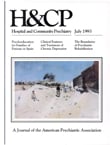A General Hospital Day Program Combining Peer-Led and Professional Treatment of Cocaine Abusers
Abstract
Objective: Cocaine abuse, particularly in crack form, is highly prevalent among patients with severe socioeconomic disadvantages who are treated in municipal general hospitals. The authors describe and evaluate a day treatment program for 30 such patients that combines peer-led self-help and professional care provided by a general hospital psychiatric service. Methods: Treatment outcomes at one year for 92 patients referred to the day program from the hospital's psychiatric services and 58 perinatal patients referred from the obstetric services were examined using chi square and regression analyses to determine whether certain variables, especially referral source, were related to outcome. An acceptable treatment outcome was def med as three successive negative urinalyses before termination or at the end of one year of treatment. Results: Almost all the patients were unemployed members of ethnic minorities, and most abused at least one substance in addition to cocaine. The l50 patients attended the program an average of 44 times during the year, and 39 percent had an acceptable treatment outcome. Patients referred from psychiatric services bad a better outcome than perinatal patients. Conclusions: Peer-led milieu treatment and professional services can be combined in the general hospital to provide intensive ambulatory care f or socioeconomically disadvantaged substance abusers. Techniques and services for engaging perinatal patients in treatment should be developed.
Access content
To read the fulltext, please use one of the options below to sign in or purchase access.- Personal login
- Institutional Login
- Sign in via OpenAthens
- Register for access
-
Please login/register if you wish to pair your device and check access availability.
Not a subscriber?
PsychiatryOnline subscription options offer access to the DSM-5 library, books, journals, CME, and patient resources. This all-in-one virtual library provides psychiatrists and mental health professionals with key resources for diagnosis, treatment, research, and professional development.
Need more help? PsychiatryOnline Customer Service may be reached by emailing [email protected] or by calling 800-368-5777 (in the U.S.) or 703-907-7322 (outside the U.S.).



